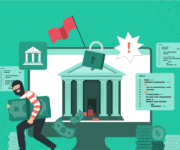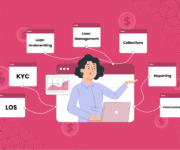Every lending operation is two-way traffic, which generally involves extending a loan and then recovering that loan. However, the ground reality is far from being two-process simple.
Many financial institutions and lenders have to bear the brunt of delinquent loans despite keeping numerous checks in place. And if these loans are left unchecked, their bulk can slowly penetrate business operations and leave them gasping for air.
There can be several reasons for a borrower to default on their payments when it comes to delinquent loans. However, knowing how to recover loans from defaulters is crucial in mitigating the financial impact of such situations. But a suitable lender ensures no stone unturned in recovering what can be best managed to stay themselves afloat.
It is best to rely on some tried and tested loan recovery techniques in such a situation. So let’s look at them and understand how these techniques can help.
Four Loan Recovery Techniques Every Lender Must Know About!
The quote ‘Prevention is better than cure’ cannot be more apt when applied to the lending industry. To prevent loans from turning into bad debts, here are some useful techniques to use much earlier on in the lending lifecycle, along with techniques to make loan recovery efficient and resourceful.
1. Understand the applicant’s creditworthiness better
Nothing could help a lender quicken their loan recovery process better than ensuring they only lend to credible customers in the first place. Lenders must explicitly communicate they lend to people who have an excellent credit score and the potential to repay the loans on time.
To communicate and maintain this stance effectively, numerous data sources enumerate an applicant’s financial health.
More so today, with solid digital records at the disposal of lenders and a lot of fintech coming up with innovative lending solutions, lenders are in a good position to lay their hands on critical data points and paint an accurate picture of their applicant’s repayment capacity.
Some credit data that can be typically used to do this include:
- Employment data
- Banking information
- Purchase habits, records of spending
- Rental history
- Payment history of phone bills, utilities etc
- Real estate owned
- Data on previous bankruptcies, if any.
For instance, Finezza’s Loan Origination System puts some robust monitoring systems like –
- Automatic Document Identification
- Easy API integration
- Loan-Eligibility estimator
- Bank Statement Analytics
- 360-degree customer profile assessment
- Threat detection and
- Credit Assessment Tools
– at the disposal of new-age lenders to help them make informed lending decisions.
2. Automate collections
Debt collection can no longer be a manual strategy, and lenders need to ensure enough means to collect timely payments from borrowers without any human intervention.
A dedicated collection system nudges borrowers to pay on time without any delays. This is of enormous importance for lenders who manage a diversified clientele and need to keep track of all their due payments.
Deploying a collection CRM that delegates relevant borrowers to teams and agents initially in the loan funnel can be extremely useful.
Modern-day CRMs also include appropriate tools to categorise borrowers on their repayment capacity and suggest relevant collection strategies.
There can be many categories that lenders can customise as per their needs. For example, location, loan type, default amount, past loan history, Days Past Due etc.
Along with automating timely collections, these CRMs can also automate suitable communications to debtors based on the lenders’ requirements.
3. Monitor customers’ activities in real-time
Lenders can benefit from keeping a check on the real-time activities of their borrowers through pre-defined systems. For example, whenever a borrower makes a payment, the lender’s team is notified and kept in the loop.
This ensures that the same borrowers are not hassled with unnecessary contact for collections from the lender, leading to a better customer experience. It also helps save a lot of time and effort on the entire team.
Besides, many loan origination systems help lending institutions to perform regular checks on the performance of their lending portfolio.
A real-time monitoring of their customers will only help lenders keep an eye on the status of their own business in real-time.
4. Use of loan origination systems
As mentioned above, it is always a good idea to deploy the latest loan origination system software into the processes of a traditional lending firm.
The vast expanse of services offered by this software helps cut down the loan turnaround time substantially and helps save tremendous amounts of time, effort, and cost in the process.
Most modern-day loan origination systems are excellent tools that offer out-of-box integration using APIs for gathering alternative credit data sources. This feature can prove to be fruitful in arriving at quality lending decisions.
These sophisticated systems extract data from credible sources and present it in one standardised format for the lender’s perusal, highlighting the applicant’s creditworthiness much better.
Borrowers today are open to receiving credit directly via the lender’s official website or portals, which is made possible through Artificial Intelligence (AI) in the loan underwriting process.
A good loan origination system will ensure every aspect of the lending process – from loan processing to loan disbursal and loan recovery – is streamlined in a manner that assists lenders in the long run.
5. Trace debtors
Lenders realise that one of the reasons their loan amount never gets returned to them is that some of the borrowers relocate without providing them with their new address.
The process of loan recovery becomes even more difficult in such cases without having a tangible address to reach out to in the event of a defaulter not reverting or complying with the company policies.
In such a scenario, lenders have the option of availing services of tracing firms that help lending companies trace defaulters. These firms specialize in how to recover loans from defaulters and can prove to be great agents to the lender that allows them to collect and recover loans effectively.
An effective and efficient loan recovery strategy is a prerequisite for running a successful lending company. The above loan recovery techniques are some of the important strategies that can be applied by every lender in the process of loan recovery for a smoothly running profitable business venture.
Finezza offers class-leading Lending Lifecycle Management and Credit Evaluation services. Contact us today to integrate your services with Finezza.




Leave a Reply